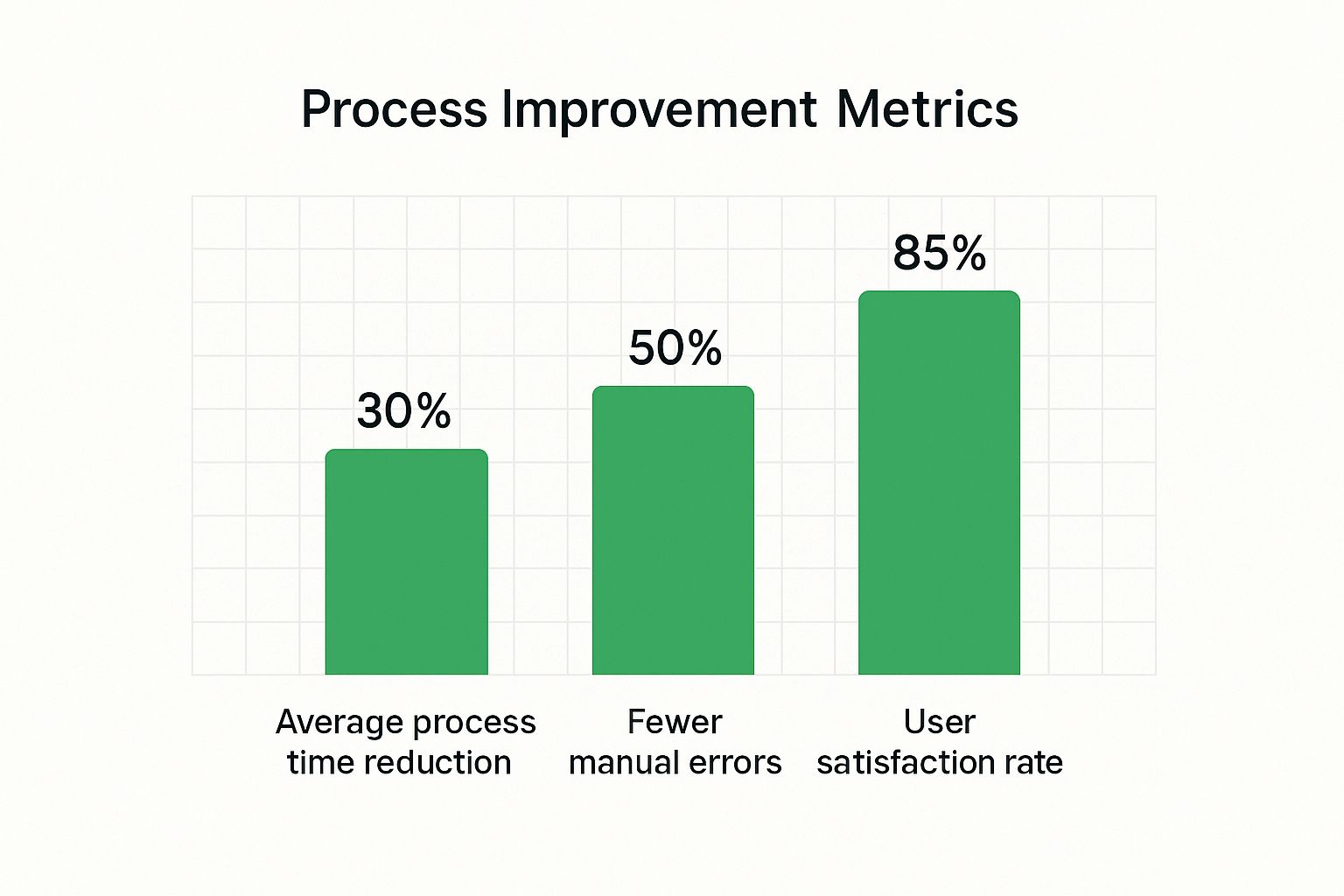Explore the best document workflow software to simplify your processes. Find features and benefits that help your business stay organized and efficient.
Ever tried running a professional kitchen during a dinner rush without a system? Orders get lost, ingredients are misplaced, and total chaos takes over. For too many businesses, that’s exactly what handling documents manually looks like.
Document workflow software is the master chef in this scenario, stepping in to bring order by automating every single step, from the moment a document is created to the day it’s archived.
At its core, document workflow software turns messy, paper-based tasks into smooth, predictable digital processes. Instead of chasing down signatures or digging through endless email chains for the latest version of a contract, the software makes sure the right document gets to the right person at exactly the right time—all automatically.
Think of it less like a digital filing cabinet and more like a strategic tool for running a tighter ship.
The idea is simple: you create a digital pathway for your documents to follow, based on a set of rules you define. For example, a new invoice could be automatically scanned, sent to a manager for approval, and then forwarded to the accounting department for payment. At each stage, a notification is sent out, so nothing gets lost on someone’s desk or buried in an inbox.
This shift toward structured, automated processes isn’t just a niche trend; it’s a massive movement. The global workflow management system market, which includes document workflow software, is projected to skyrocket from ****70.9 billion by 2032. That kind of explosive growth signals a universal business need for better efficiency and fewer mistakes.
The chart below shows just how big the payoff can be, with real-world data on improvements in process time, error reduction, and overall user satisfaction.

As you can see, the impact is huge. Businesses aren’t just getting things done faster; they’re also boosting the quality and accuracy of their work in a big way.
To really grasp the difference this software makes, let’s compare the old way of doing things with the new, automated approach.
The table makes it pretty clear: sticking with manual methods means accepting bottlenecks and risks as part of your daily operations. An automated workflow, on the other hand, builds efficiency and control directly into your processes.

To really get what makes document workflow software tick, you have to look under the hood. It’s not just about a list of bells and whistles; it’s about the engine that drives it all. These core capabilities are the building blocks that transform messy, manual processes into dependable, hands-off systems.
At the very heart of it all is automated routing. Think of it as a smart GPS for your business documents. Instead of someone having to remember to email a contract to the next person, the software automatically pushes it along a pre-set path. A new sales contract, for instance, can glide from the legal team for review, over to finance for approval, and finally to the client for a signature—all without anyone lifting a finger.
This slick routing is all made possible by rule-based logic.
These rules are basically the “if this, then that” commands that run your workflows. You set the conditions, and the software takes care of the action. It completely removes the guesswork and makes sure company policies are followed to the letter, every single time. A classic example is setting a rule to automatically flag any invoice over $10,000 for a manager’s review, stopping unauthorized spending in its tracks.
By setting up these rules, you’re essentially creating a self-managing system that handles all the routine decisions. This frees up your team to tackle the more complex, high-value work. This foundation of logic is precisely what makes document workflow software so powerful when you scale up.
But what happens when multiple people need to work on the same document? That’s where another crucial piece comes in.
Have you ever wasted hours because team members were accidentally working on an old draft of a report? It’s a frustratingly common problem. Version control puts a stop to that by creating a single source of truth for every document. It meticulously tracks every single change, ensuring everyone is always looking at the most current version.
Working hand-in-hand with this is the audit trail. This feature creates a tamper-proof digital log of every single action taken on a document. It records who viewed, edited, approved, or shared a file, complete with a precise timestamp. For compliance and security, this kind of transparency is a non-negotiable. It gives you a complete, verifiable history for any audit.
Let’s pull this all together with a real-world scenario.
Example: Employee Onboarding
Let’s be honest: bringing in new software isn’t just about cool new features. It’s about solving real problems and seeing a tangible return on your investment. When we talk about the case for document workflow software, we’re moving past simple convenience and into core business performance. This is about making measurable improvements in how you work, how secure your data is, and how well your teams collaborate.
As many modern companies are discovering, the investment pays off handsomely. You can see this by understanding the core process automation benefits that are becoming standard.
The most immediate win? You get your team’s time back. Think about all the hours lost to manual, repetitive work: chasing down approvals, printing and scanning stacks of paper, or digging through emails to find the latest version of a file. These tasks are productivity killers.
By automating them, companies can reclaim hundreds of work hours every year. This isn’t just about trimming costs. It’s about shifting your team’s energy away from tedious admin work and onto the strategic, high-value activities that actually grow the business.
In today’s world of tight data regulations, having solid security isn’t just a good idea—it’s non-negotiable. Automated workflows give you a much stronger security posture in a few critical ways.
This level of built-in control is crucial for meeting regulations like HIPAA or SOX. It turns compliance from a stressful, periodic headache into a smooth, continuous, and automated practice. For teams working in agile environments, keeping information this organized and accessible is a game-changer. You can dive deeper into this topic in our guide to agile development documentation.
We’ve all seen it. Each department has its own way of handling documents, and crucial information gets trapped in separate systems. A centralized workflow platform acts as a bridge between these islands, creating a single source of truth that everyone can rely on. This is where real collaboration starts.
Imagine a company drowning in manual invoice processing. Before automation, invoices would get lost, payments were constantly late, and relationships with suppliers were strained. By putting a workflow solution in place, they brought order to the chaos. Invoices were automatically captured, routed for approval, and paid on time. The ROI wasn’t just in the hours saved; it was in healthier cash flow, better terms from vendors, and a much stronger position in the market.

This is where the rubber meets the road. The true power of document workflow software isn’t in its abstract features but in how it solves real, high-stakes problems for different industries. It’s not a one-size-fits-all solution; think of it more like a precision toolkit that can be configured for highly specialized environments.
From the sterile corridors of a hospital to the high-pressure deal-making of a law firm, the core ideas of automation are applied to wildly different processes. Each field has its own regulatory headaches and operational targets, and seeing the software in action reveals its tangible impact on efficiency and compliance.
This adaptability is exactly why document workflow software has become so vital for any business looking to modernize. We’re seeing this trend accelerate. A recent document workflow software industry report shows the market is set for major growth from 2025 onwards as more organizations realize they need these tools to handle approvals, routing, and compliance with far greater control.
In healthcare, there’s zero room for error. Accuracy and compliance aren’t just goals; they’re legal requirements. Document workflow software steps in to automate the entire patient intake process, from the moment a patient fills out a digital form to the final verification. New patient data is instantly routed, checked for missing information, and fed directly into the electronic health record (EHR) system, slashing the manual entry errors that could compromise patient care.
The same logic applies to the nightmare of insurance claims. The software can:
For legal teams, time is quite literally money. A contract stuck in someone’s inbox can kill a deal. Document workflow software is a game-changer here, managing the entire contract lifecycle—from the first draft to the final e-signature—and knocking down the bottlenecks that bring everything to a halt.
Imagine a contract draft that automatically routes to the internal counsel for review. Once they give the green light, it zips over to the department head, and finally, shoots out to the client for their signature. Every step is tracked, and every version is saved. No more wasting time on an outdated draft.
Finance departments are drowning in critical documents, and accounts payable (AP) is often the biggest culprit. An automated AP workflow can turn this manual, error-prone mess into a well-oiled machine.
The system uses optical character recognition (OCR) to “read” and capture data from an invoice the second it arrives. It then automatically matches the invoice against the right purchase order and routes it for approval based on rules you’ve already set, like the invoice amount.
Once it gets the final nod, the payment is scheduled with almost no human touch. This doesn’t just get bills paid faster; it gives finance leaders a crystal-clear, real-time picture of cash flow and liabilities. The result is a more accurate, transparent, and frankly, less stressful financial operation.
Picking the right software isn’t about grabbing the most popular name off the shelf. It’s about finding a solution that fits your company’s unique DNA. A confident choice comes from a clear strategy, and that strategy begins with a deep, honest look at your current processes. Think of it less as a casual glance and more as a diagnostic exam.
First things first: map out your existing workflows. Who touches a document as it moves through its lifecycle, like a contract approval or an invoice payment? Where are the digital traffic jams? Pinpointing these bottlenecks and the key players involved gives you a concrete, non-negotiable list of requirements for any new system you consider.
Your business is going to grow, and the last thing you want is software that holds you back. True scalability means your document workflow software can effortlessly handle more documents and more complex processes as you expand. A system that’s great for 100 invoices a month needs to be just as reliable when you’re processing 10,000. Don’t be shy about asking vendors how their platform is built for growth and what their pricing looks like as you scale.
Just as critical are its integration capabilities. Your new software needs to play well with the other tools you already rely on every day.
Without these connections, you’re just creating another isolated island of information—and that defeats the whole purpose of creating a unified workflow in the first place.
Once you know exactly what you need, you can talk to vendors with a clear set of questions. This helps you see past the slick sales presentations and get to the heart of what they actually offer. It’s about understanding the full picture of document workflow management, which goes far beyond a simple feature list.
To guide your conversations and compare your options fairly, it helps to use a checklist. It keeps the evaluation grounded in what truly matters for your business’s health and security.
Here’s a simple checklist to get you started.
By arming yourself with this structured approach, you can cut through the marketing noise. You’ll be much better equipped to select a solution that won’t just solve today’s problems but will serve as a genuine, long-term partner in your company’s success.

Buying the software is the easy part. The real work begins when you have to weave it into your team’s day-to-day routines. A great rollout plan is less about the tech and more about the people, proving the software’s worth from the get-go. Without a smart approach, even the most powerful tool will end up gathering digital dust.
The best strategy I’ve seen over the years is to start small to win big. Don’t try to boil the ocean by automating every single process at once. Instead, pick one high-visibility workflow that’s relatively simple to digitize. Things like expense reports or vacation requests are perfect starting points.
Nailing a small, visible win builds incredible momentum. It shows everyone, “Hey, this thing actually works and makes our lives easier,” which is exactly what you need to get people on board.
The ultimate test of any new software is whether people actually use it. To sidestep resistance, you need to involve your team from the very beginning. Forget top-down mandates; invite the end-users—the people who will be in the system every day—to help design the new workflows.
Of course, you can’t just throw them in the deep end. You need solid support structures in place. This means creating simple training guides and appointing an in-house expert who can answer questions and smooth out any bumps. For a deeper dive into creating helpful materials, check out this software documentation best practices guide. A successful rollout is always grounded in solid document management best practices.
Finally, you have to know what success looks like before you even start. You need to establish clear, measurable Key Performance Indicators (KPIs) to track your progress and justify the investment to leadership. A vague goal like “improve efficiency” just won’t cut it.
Get specific with your targets. Aim for things like: